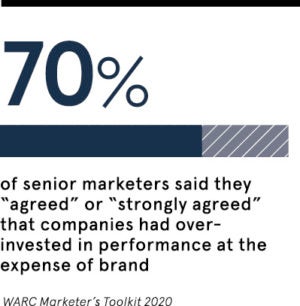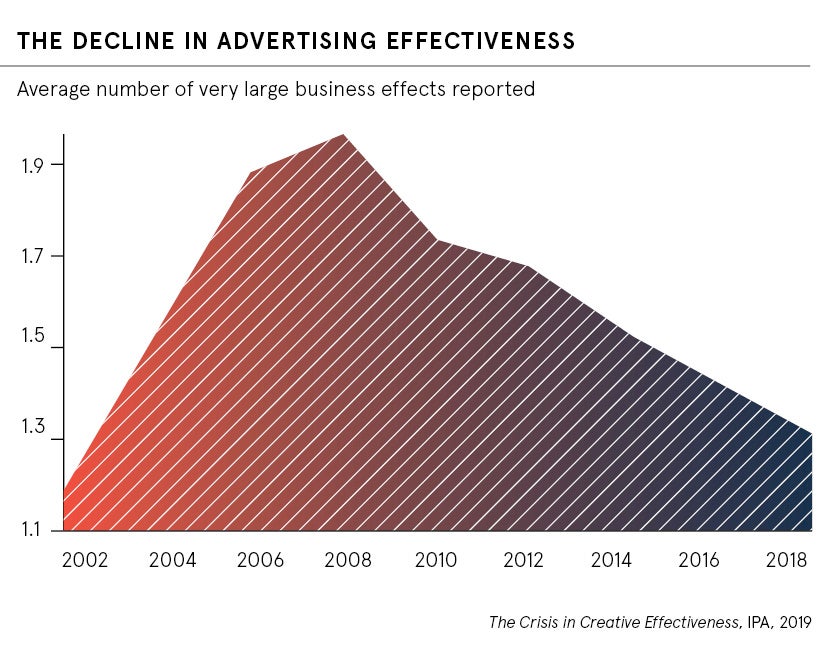That’s the finding of a series of research reports documenting the unintended consequences of a fixation of short-term goals by the world’s senior marketing decision-makers.
In 2010, following the global financial crisis, marketing directors found themselves under enormous pressure from shareholders and board members to justify their spend and clearly demonstrate the return from any investment.
At the same time, a new generation of employees had entered the workplace. This social media-savvy addition to the workforce made a convincing case for upping spend on social content, aiming to drive revenues and digital performance.
Subsequent years saw an increasing percentage of budgets allocated to short-term sales, with an almost obsessive focus on price and promotion-sensitive campaigns. But this was all at the expense of investment in long-term brand growth, something which experts are now warning has reached critical levels.
What’s at stake?
 After the financial crash, the effectiveness of advertising campaigns tumbled to levels not seen since the dotcom bubble burst in 2001, according to 2019 data from the Institute of Practitioners in Advertising (IPA).
After the financial crash, the effectiveness of advertising campaigns tumbled to levels not seen since the dotcom bubble burst in 2001, according to 2019 data from the Institute of Practitioners in Advertising (IPA).
The Crisis in Creative Effectiveness report clearly shows a steady year-on-year decline, so it is perhaps unsurprising senior marketing figures are instigating changes in how they structure their campaigns, resources and budgets.
Research group WARC, which considers advertising and media effectiveness, published its respected Marketer’s Toolkit at the beginning of the year. The results of this year’s poll of 800 marketing specialists, supported by interviews with ten chief marketing officers at global blue chip brands, made for uncomfortable reading.
A “crisis of short-termism” and an “over investment in performance marketing” were the key takeaways. Of the 800 people surveyed, a massive 70 per cent said they “agreed” or “strongly agreed” that companies had over-invested in performance at the expense of brand.
Why does this matter?
Brand campaigns are essential to companies that want their clients to trust they offer high-quality products and services. Strong brands can also support superior pricing against the peer group and enhance customer loyalty.
Significantly, there is also evidence emerging that customers are becoming choosier about their buying decisions, based on the strength of a company’s brand. According to the most recent State of the Connected Customer report by Salesforce, 73 per cent of customers say trust in companies matters more than it did a year ago.
Furthermore, customers are becoming even more selective in the brands they do trust, with 54 per cent of those surveyed saying it is now “harder than ever” for a company to earn their trust.
But while business leaders and senior marketers have recognised the need to invest in the long-term growth of their brand, a decade-long binge on short-term campaigns has left them ill-equipped to do so.
For many, there are entire marketing teams that have been a part of the workforce for ten years without once having seen a brand development campaign executed. A 2019 IPA/Financial Times study found that around one in three senior marketers rated their ability to build brands as “average” to “poor”.
Seeking assistance
For those who need help stimulating long-term brand growth, a strategic gear change could be the way forward. Southpaw is a market leader and we believe our process is truly one of a kind.
As a boutique creative agency, owned by the global marketing group Hakuhodo, we develop strategic brand campaigns, informed by neuroscience and behavioural science. Our unique methodology, developed in-house, informs client campaigns, allowing us to anticipate how to build long-term brand growth, through heuristics, behavioural bias analysis and neuro-mapping.
Southpaw’s scientifically driven team uses our proprietary system to build bespoke client audiences by harnessing data that aligns to neuro-mapping principles. This allows us to analyse clients’ target audiences and predict how those brand messages will be received. It also enables us to employ the techniques which will have the highest chance of influencing buyer behaviours and ultimately building long-term brand growth.
As senior decision-makers recognise the need to strengthen brands, we believe it is time to seek help from those who have invested in the methodology, resource, technology and personnel to deliver, and prevent another decade of declining creative effectiveness.
For more information please visit southpawagency.com
What’s at stake?

Why does this matter?

